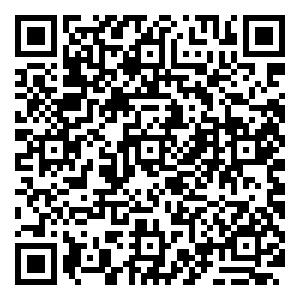-
Technological developments have occurred throughout history to increase agricultural productivity with limited resources. However, population growth, climate change, labor shortages, and rising labor costs due to an aging population create a continuing tension between food supply and demand. The world population is expected to reach 9 billion in 2050[1]. The FAO estimates that agricultural production should increase by 50%−60%[2]. Due to various constraints such as temperature, terrain, soil, water quality, etc., only a small area of land is suitable for agriculture. In addition, agricultural land is shrinking due to economic and political factors such as population growth, climate, land use, and rapid urbanization[3]. While urbanization, soil erosion, and land degradation reduce the area of agricultural land, water scarcity, and inadequate irrigation systems also hinder healthy growth and production. Pests, diseases, and pathogens also significantly affect plant health[4]. In this context, 'Smart agriculture' has become a paradigm shift strategy that uses technological advances to transform agriculture.
Smart Agriculture (SA) aims to provide solutions that reduce dependence on human energy and increase the efficiency of agricultural operations. Traditional agriculture faces constraints due to a lack of resources and environmental concerns. Intensive agricultural practices cause excessive use of fertilizers and pesticides that cause soil pollution and increase greenhouse gas emissions[5]. However, SA uses efficient agricultural methods that rely on technology and knowledge to ensure the best use of resources. Thanks to real-time data from high-resolution sensors and satellite images, farmers can use resources more efficiently, significantly reducing waste and environmental impact[6].
Traditional agricultural practices have been replaced by tractors, harvesters, and autonomous weeders using microtechnology[7]. These smart machines perform simple and highly efficient tasks. Farmers benefit from increased production and reduced labor, creating positive impacts on agriculture. Environmental protection is an important aspect of sustainable agriculture. These goals are combined with agricultural technology aimed at protecting the environment. SM improves ecosystems by reducing the need for chemicals to support sustainable agriculture[8,9]. This review article aims to reveal the importance of precision agriculture in increasing agricultural production and the importance of environmental protection in increasing production and reducing traditional production.
-
'Industry 4.0' is a term adopted during the Fourth Industrial Revolution, defining the limits of technological advancement. Agricultural development can be linked to various industrial revolutions and has developed gradually[10,11] (Fig. 1).
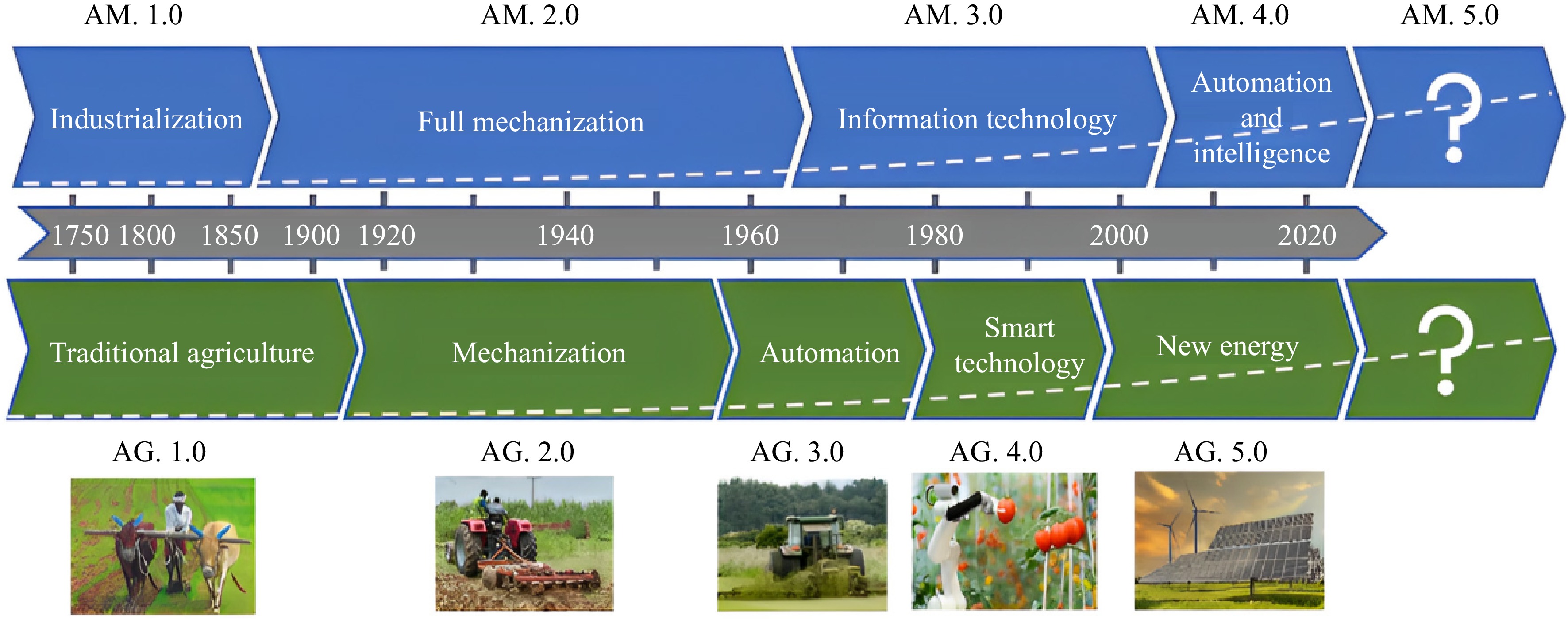
Figure 1.
Trends in agricultural development[11].
This period represents a major change, from Agriculture 1.0, which represents the era of traditional agriculture from 1784−1870, characterized by early agricultural methods based on manual labor using hand tools and animal power, crop rotation practices, polyculture, limited use of chemical fertilizers and pesticides, and reliance on local knowledge and practices. The issue of this stage was low operational efficiency, to Agriculture 4.0, the era of smart agriculture, which began in 2017, transforming the agricultural sector into digital technology by integrating Internet of Things (IoT) devices for real-time monitoring, using Artificial Intelligence (AI) and Machine Learning (ML) for predictive analytics, automating agricultural operations, and focusing on sustainability and reducing environmental impact. Agriculture 2.0 represents the mechanized agricultural era of the 20th century. This process began with the introduction of agricultural machinery and machines to increase productivity and reduce manual labor, including inefficient use of resources. Later, Agriculture 3.0, the era of rapid development of mechanized agriculture from 1992 to 2017, also known as Precision Agriculture (PA), introduced advances in computers and electronics based on global positioning system (GPS), geographic information system (GIS), sensors, IoT devices, data collection and analysis for informed decision-making, and remote sensing (RS), which led to increased productivity and efficiency in agricultural systems. One of the issues of this stage is the low level of intelligence[12−14].
Agriculture 5.0 means integrating new technologies and alternative energy sources into agricultural practices. Real-time weather updates, remote monitoring, access to affordable financial services and smart farms will solve the energy problems of the future by combining these technologies with green energy sources. Implementing Agriculture 5.0 using green energy sources have the potential to create a lower-cost, more efficient, and more sustainable energy model[15].
Precision Agriculture (PA)
-
The development of wireless sensor networks (WSNs) is a major contribution to the development of AP (AG 3.0), an advanced technology aimed at increasing crop productivity[16]. WSNs and agriculture can reduce risks in the production process and help farmers make decisions by placing low-power, multifunctional sensors on farmlands[17]. RS, GIS, and GPS are a set of modern information technologies mainly used in AP[18]. In PA, AI, and various types of data (such as GPS, GIS, and RS data) propose crop production management to understand the crop growth process and specialized decision-making systems. Personal experiences form the basis of traditional agricultural production management methods[13].
The use of PA reduces fuel consumption, agricultural inputs, labor time, human errors, and effort[19]. Among these processes are management techniques to reduce input use, fuel consumption[20], and soil erosion and compaction by reducing tillage resistance[21]. When it comes to capturing and using technology, both methods are applied simultaneously to reduce the use of agricultural products. Logging technology that uses sensors to provide specific information about insects, soil, water, and plant nutrients. Therefore, Collaborative Technology uses this geographic data to determine how agricultural inputs vary by region. Several studies have evaluated the reduction in agricultural inputs when targeting nutrients, especially fertilizers, using near and far sensors. These minerals absorb radiation that plants do not use. By plant standards, the best plants show a lot of yellow-green color. Current literature ranks fertilizer use between 1.6%−82% using proximity sensors[22], and in the case of remote sensors, these numbers range between 6%−50%[23].
Life cycle assessment (LCA) is now a widely used method to quantify the potential impact of new agricultural systems and technologies[24]. It has been used in some studies to evaluate the environmental impacts of genetic modification technology in crop production, especially in the use of pesticides and fertilizers. Gasso et al.[25] conducted a life cycle evaluation of Controlled Traffic Farming (CTF) in Denmark and gave good results due to a significant reduction in self-management, resulting in a reduction in the use of fertilizers and pesticides. Medel-Jiménez et al.[26] studied the environmental impacts of using an optical crop sensor for variable rate nitrogen application (VRNA). The study findings showed an 8.6% reduction in global warming based on the sensor under good conditions. Li et al.[27] performed LCA on VRNA via plant sensors. The results of the experiment showed a decrease in global warming, acidification potential, and eutrophication potential due to reduced nitrogen fertilization.
Precision Agricultural Systems
-
Traditional agricultural systems (conventional schemes) depend on old methods of managing agricultural operations, and it is assumed that the use of digital technology in this system does not exist. Among the AP systems are:
Automatic steering system scheme
-
Automated guidance is a hands-free navigation technology that uses the Global Navigation Satellite System (GNSS), allowing drivers to follow the path needed to navigate with high accuracy. These systems are used to improve geological information using Real-Time Kinematics (RTK) signals and GNSS signals[28]. An automatic steering system can reduce excessive errors associated with manual steering. In this way, diesel consumption is kept to a minimum[20]. Medel-Jiménez et al.[28] conducted a study on reducing the rate of diesel consumption during the use of disc harrows, heavy agricultural machinery, precision seeders, and spraying. It was concluded that the reduction in the use of fertilizers, seeds, and pesticides compared to the consumption of diesel is equal.
Automatic section control scheme
-
The Automated Control System (ASC) combines steering and reaction technologies. The ASC uses both GNSS and RTK to record 2 cm accurate geolocation data[29]. This technology aims to automatically deactivate the seeding machine or spraying machine, so that when it passes over the same site, spraying or seeding is stopped, thus preventing excessive use of fertilizers, pesticides, and seeds[30]. This system also helps reduce diesel consumption, because the ASC usually works in conjunction with automatic steering systems.
Proximal sensors scheme
-
Sensors installed near crops serve as a technology for recording purposes as they measure the plant vegetation index by measuring the reflected radiation that is not absorbed by the plant's VRNA[31]. These sensors can function as portable devices, ground stations, or installed on agricultural machinery. Based on vegetation data obtained from sensors, a productivity variation map can be created[32].
Prescription maps scheme
-
Remote sensors measure the vegetation index based on images taken from drones or satellites[28]. Specific programs are used to analyze and process these images for the purpose of creating crop contrast maps. Variability maps are used by variable rate techniques to measure nutrient input rates based on crop needs in the field.
To compare traditional systems and AP systems in terms of their impact on the ecosystem, Fig. 2 shows the improvement per cultivated hectare and the potential reductions.
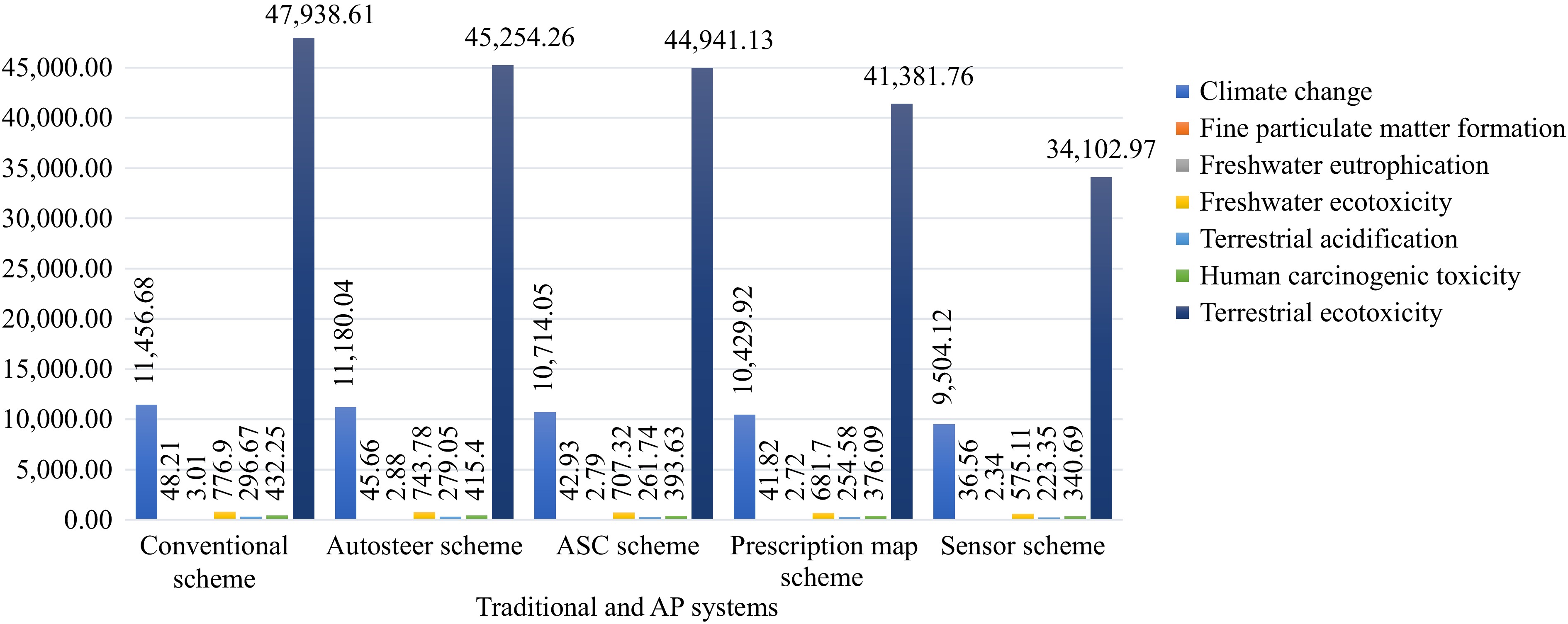
Figure 2.
Comparison between traditional and AP systems per cultivated hectare[28].
Based on the results in Fig. 2, it is clear that the highest reductions in climate change were in the sensor scheme, followed by the prescription map, the ASC scheme, and the Autosteer scheme. Based on these results, it can be concluded that there is the possibility of using various AP techniques for the purpose of reducing environmental impacts on agricultural crop productivity.
Smart Agriculture (SA)
-
SA has played a major role in initiating a digital transformation in the agricultural sector. Today, Agriculture 4.0 represents a new revolution that involves the integration of digital technologies into agricultural operations as well as the impact of Industry 4.0 across various sectors. This combination of industrial revolution and agricultural development underscores the importance of using agriculture to shape the future of crop production and solve the problems that threaten modern agriculture[13]. Looking to the future, a significant increase in the use of robotics and automation technologies in the agricultural sector is expected. It has been proven that solar-powered machines can operate without interruption for a long period oftime. Therefore, these robots and automation technologies contribute to opening new ways to increase the efficiency and productivity of agricultural activities and reduce fuel and energy consumption while protecting ecosystems. Advances in robotics have also led to the development of flying microrobots inspired by insect mechanics[33]. The scientific and technical importance of robots in agriculture is evident from their ability to increase productivity, develop knowledge, and solve agricultural problems. In addition, the integration of cutting-edge technology such as optoelectronics and sensors facilitates the robot's ability to increase work efficiency[34].
Some key technologies of particular relevance to Agriculture 4.0, along with their capabilities and impacts on sustainable farm management, are summarized in the following subsections.
Internet of Things (IoT)
-
Agricultural IoT networks, an important technology for smart agriculture, enabling measuring environmental factors, crop growth, and production processes through automatic processing, analysis, and access[35]. As shown in Fig. 3, the IoT architecture consists of perception, transmission, and application layers. The perception layer uses different sensors to obtain information about crop growth and field environment and determines the environmental condition[36]. The transmission layer includes network communication protocols that enable the data collected by the detection layer to be transmitted to the application layer based on these protocols. The extensive outdoor environments in PA are not suitable for using technologies with low transmission range (e.g., Wi-Fi and Thread) and high power consumption (e.g., Wi-Fi). In addition, low data rate technologies (e.g., Z-Wave, LoRa, and 2G(GSM)) are not suitable for some technologies that provide high-throughput data transmission. One such technology is the Plant Phenotype Information System. The application layer is critical for both cloud systems (e.g., multi-server) and local systems (e.g., gateway-based edge computing). The application layer includes the following functions:
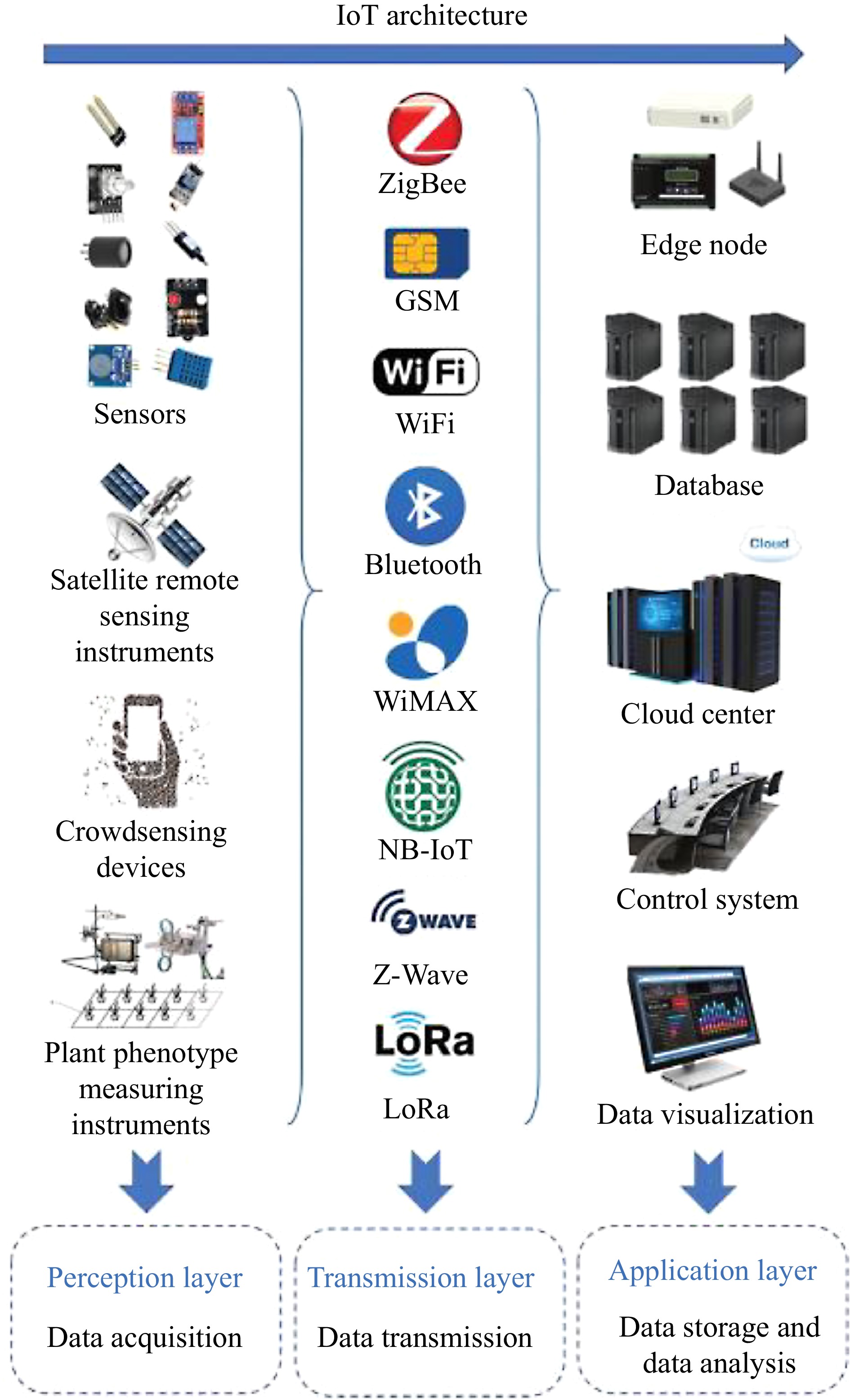
Figure 3.
Different technologies and applications are based on the IoT architecture[13].
• Data storage, such as cloud platforms and Hadoop distributed file systems[37];
• Data management, such as supervisory control and data acquisition (SCADA) for real-time data monitoring[38];
• Data analytics, such as decision-making systems, plant instructions, and production models for automated control of agricultural production[39];
• Data commercialization, such as data visualization, ownership, privacy, and new business models for agricultural products[40].
Resource management and monitoring of agricultural conditions, the use of wireless sensor networks (WSNs) for data transmission, and the use of decision support systems for analysis are the focal points of agricultural IoT applications[41]. Using technologies such as Radio Frequency Identification (RFID), IoT applications can track animal growth and health and maintain environmental stability by monitoring indoor and outdoor conditions[42]. However, it enhances plant growth by monitoring and controlling the growth environment such as light, humidity, and temperature[43]. IoT for smart irrigation and livestock focuses on smart irrigation systems and livestock management systems that optimize water usage through real-time data required[44].
Artificial Intelligence (AI) and Machine Learning (ML)
-
Agriculture faces many problems such as seed planting, pesticide control, weed management, crop disease, lack of irrigation and drainage systems or even lack of storage management. AI and ML applications provide intelligent software applications and systems that incorporate cognitive work processes to reduce prediction costs in decision-making, increase agricultural accuracy and productivity, and finally increase agricultural accuracy and productivity[45,46]. Since agricultural environments contain a wealth of information, different levels of data abstraction and feature selection techniques such as classification and clustering must be used to capture the full contextual value of heterogeneous data. In multi-sensory environments, data fusion classification techniques in particular can be widely used to integrate and aggregate data from multiple, heterogeneous, distributed sensors (such as sensors used in agricultural fields) to achieve higher reliability and lower probability of detection error[47,48]. Moreover, using ML techniques, financial management systems can be transformed into true AI systems and provide more advanced recommendations and insights for subsequent decisions and actions. This is aimed at increasing agricultural production. Therefore, shortly, practical tools compatible with the Agriculture 4.0 guidelines will enable the expansion of the integration of ML models into forest management systems through automatic data recording, data analysis, application of ML, and decision-making or support for the integration of agricultural product quality and production[49].
One of the applications of AI and ML models are smart robots that perform tasks such as planting and harvesting more efficiently than traditional methods[50]. Additionally, crop and soil monitoring analyzes data on crop growth and soil health using ML and AI, allowing farmers to make informed decisions about resource management and crop care. ML models help farmers plan for and mitigate risks associated with climate variability. They anticipate the impact of climate change on crop yields. At the same time, AI can improve operational efficiency and productivity by processing and analyzing large amounts of agricultural data[49]. AI systems based on data analytics help farmers make better decisions about irrigation, planting, and pest management. AI algorithms analyze data and images to detect plant diseases early, enabling rapid intervention and reducing crop loss[51].
Big data and analytics
-
Recent advances in IoT technology, which wirelessly connects all types of objects and devices at all stages of the cyber-physical management cycle, has helped generate a wealth of real-time data about the entire agricultural supply chain and operations. In this case, processes and transactions are an important source of process-mediated data. In addition, social media is a major source of sensory devices and robots that generate non-traditional data such as images, videos, and other machine-generated data. As a result, a vast amount of heterogeneous data is being accessed with a level of visibility and decision-making capability that was not possible before. Big data and analytics are essential components for successfully creating value from this data. By changing the scope and organization of agricultural operations, big data can be used to drive real-time operational decisions, redesign processes, and provide insights[52]. Big data applications will address important issues such as food safety and security, sustainability, efficiency improvements, and climate change. The aims of big data applications are therefore not limited to agriculture; Agriculture 4.0 standards cover all requirements in the supply chain, such as sensor deployment, measurement, predictive modeling, and risk management[53].
Agricultural robotics
-
There are currently several ways to classify and describe agricultural robots. As shown in Table 1, agricultural robot technology has been widely studied and used in poultry farming, agriculture, and aquaculture. Crop robots can be used for virtual modeling[54], monitoring and mapping, plant management, environmental control, and other purposes. Similarly, agricultural robots can perform virtual modeling[55], monitoring and management, environmental control, and other tasks in livestock, poultry, and aquaculture. In crop farming, the research and development of agricultural robots involves a variety of tasks, including plowing, grafting, planting, fertilizing, pollination, spraying, harvesting, grading, fertilizing, semi-closed greenhouses, and fully closed plant factories. There are also airborne, ground, and aquatic robotic solutions[56]. Agricultural robots can be divided into two categories: non-selective work robots and selective work robots. These categories are determined by the application method of operation and technical levels. Non-selective work robots do not distinguish the target person during work. Selective work robots identify, locate, and diagnose specific agricultural targets using sensing technologies such as machine vision.
Table 1. Classification of agricultural robot systems[57].
Aspect Type Type of industry Crop farming, livestock and poultry farming, aquaculture Function Phenotyping, monitoring, mapping, object handling, environment cleaning, health protection, etc. Intelligent level Remote-control, man-robot collaboration, full autonomous Working mode Selective, non-selective Mobility Stationary, mobile Space Aerial, ground, aquiclude In short, SA applications contribute significantly to environmental sustainability by enhancing resource efficiency, reducing the use of chemicals, conserving biodiversity, and enhancing climate resilience. As these technologies continue to evolve and become more widely adopted, they hold the promise of creating a more sustainable agricultural system that meets the needs of a growing global population while protecting the environment.
-
Figure 4 shows different agricultural practices made possible by technological innovations. Technology diffusion is a mechanism that leads to increased agricultural productivity and thus increased profits. In addition, it enables more efficient use of water, pesticides, and fertilizers, making agricultural operations more profitable. This benefit helps increase local production in addition to the benefit to farmers. Moreover, if these applications and methods become more widespread, they could create new industries or increase the impact on domestic output by boosting existing industries, such as technology companies specializing in drones or smart devices[58].
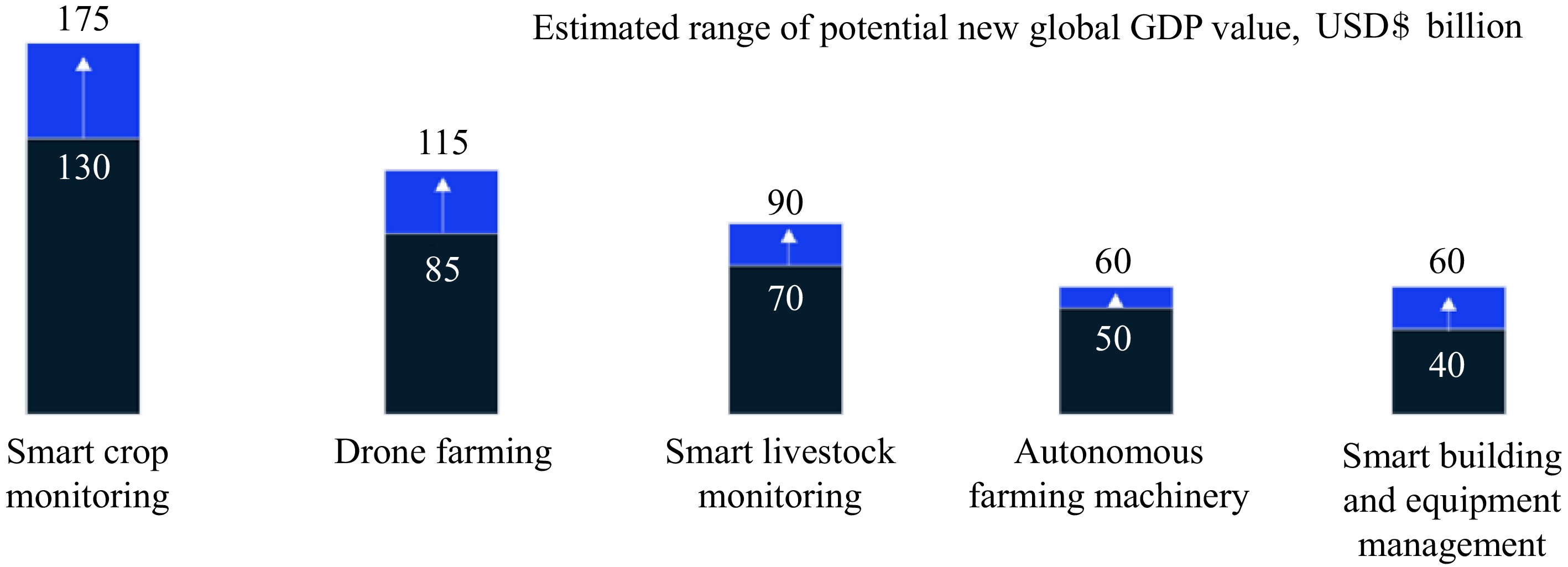
Figure 4.
Projected impact of technology on global growth in agriculture[59].
The use of modern technology in agriculture represents a major change in this sector and promises increased production and profits. These innovations are not just incremental, this represents a leap forward in farming methods. Figure 5 summarizes the expected economic impacts of introducing these technologies into global agriculture in 2050. The figure is based on a study conducted to estimate the potential benefits that technology development will bring. Statistics show an interesting trend in value growth in different areas of agricultural technology, from precision agriculture to moisture management, and strong growth potential in this sector[59].
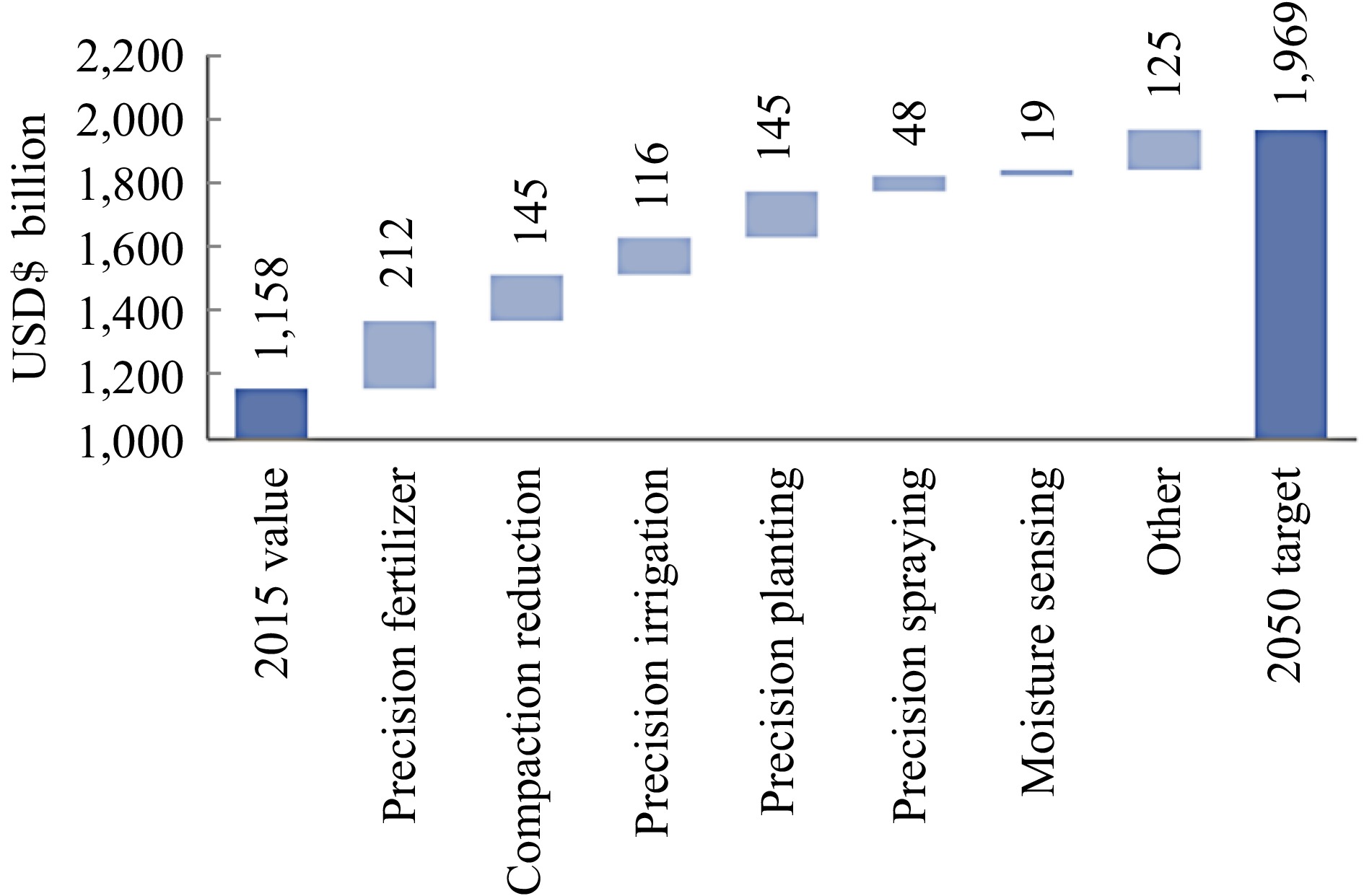
Figure 5.
Impact of the contribution of precision agriculture technologies on the expected value of global crop production[59].
Integrating modern precision technologies into agricultural operations contributes 70% to increasing productivity. In 2015, crop productivity in the world reached USD
${\$}$ ${\$} $ ${\$} $ ${\$} $ ${\$} $ ${\$} $ ${\$} $ -
This review article underscores the transformative potential of automation and precision agriculture in modern farming. It highlights that Smart Agriculture (SA) is pivotal in addressing challenges such as shrinking agricultural land, climate change, and resource scarcity. By integrating advanced technologies like IoT, robotics, and data analytics, farmers can optimize resource use, enhance productivity, and minimize environmental impacts. The findings suggest that these innovations not only improve crop yields but also promote sustainable practices by reducing reliance on harmful chemicals and excessive resource consumption. Furthermore, the article emphasizes the importance of real-time data and high-resolution sensors in making informed decisions for efficient farm management. It concludes that the adoption of these technologies is essential for the agricultural sector to thrive in the face of growing global demands. Ultimately, the article advocates for a paradigm shift towards technology-driven agriculture to ensure food security and environmental sustainability in the future.
-
The authors confirm contribution to the paper as follows: study conception and design: Al-sammarraie MAJ, Ilbas AI; data collection: Al-sammarraie MAJ, Ilbas AI; analysis and interpretation of results: Al-sammarraie MAJ, Ilbas AI; draft manuscript preparation: Al-sammarraie MAJ, Ilbas AI. All authors reviewed the results and approved the final version of the manuscript.
-
Data sharing not applicable to this article as no datasets were generated or analyzed during the current study.
-
This is a collaborative article, and funding was not available. We would like to thank the University of Baghdad and the Erciyes University.
-
The authors declare that they have no conflict of interest.
- Copyright: © 2024 by the author(s). Published by Maximum Academic Press, Fayetteville, GA. This article is an open access article distributed under Creative Commons Attribution License (CC BY 4.0), visit https://creativecommons.org/licenses/by/4.0/.
-
About this article
Cite this article
Al-sammarraie MAJ, Ilbas AI. 2024. Harnessing automation techniques for supporting sustainability in agriculture. Technology in Agronomy 4: e029 doi: 10.48130/tia-0024-0026
Harnessing automation techniques for supporting sustainability in agriculture
- Received: 01 June 2024
- Revised: 08 August 2024
- Accepted: 15 August 2024
- Published online: 08 October 2024
Abstract: Automation is one of the key systems in modern agriculture, providing potential solutions to the challenges related to the growing world population, demographic shifts, and economic situation. The present article aims to highlight the importance of precision agriculture (PA) and smart agriculture (SA) in increasing agricultural production and the importance of environmental protection in increasing production and reducing traditional production. For this purpose, different types of automation systems in the field of agricultural operations are discussed, as well as smart agriculture technologies including the Internet of Things (IoT), artificial intelligence (AI), machine learning (ML), big data analysis, in addition to agricultural robots, and finally, the economic transformations resulting from automation. SA uses technology and data-driven agriculture to increase resource utilization, reduce waste, and minimize environmental impact. Automation in tractors, harvesters, and various agricultural equipment is revolutionizing traditional agriculture, increasing productivity and efficiency, and reducing reliance on human labor. PA and SA emphasize environmentally friendly practices and reduce the inputs required to create ecosystems to protect the environment and mitigate the effects of climate change. This shows how PA and SA can help in the future of the agricultural sector.
-
Key words:
- Automation /
- Precision agriculture /
- Smart agriculture /
- Environmental protection /
- Productivity








